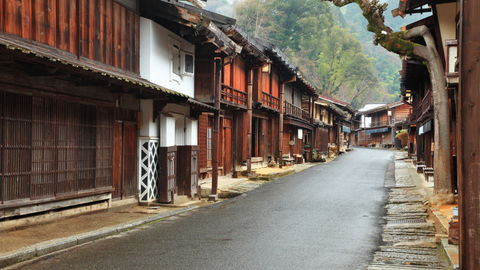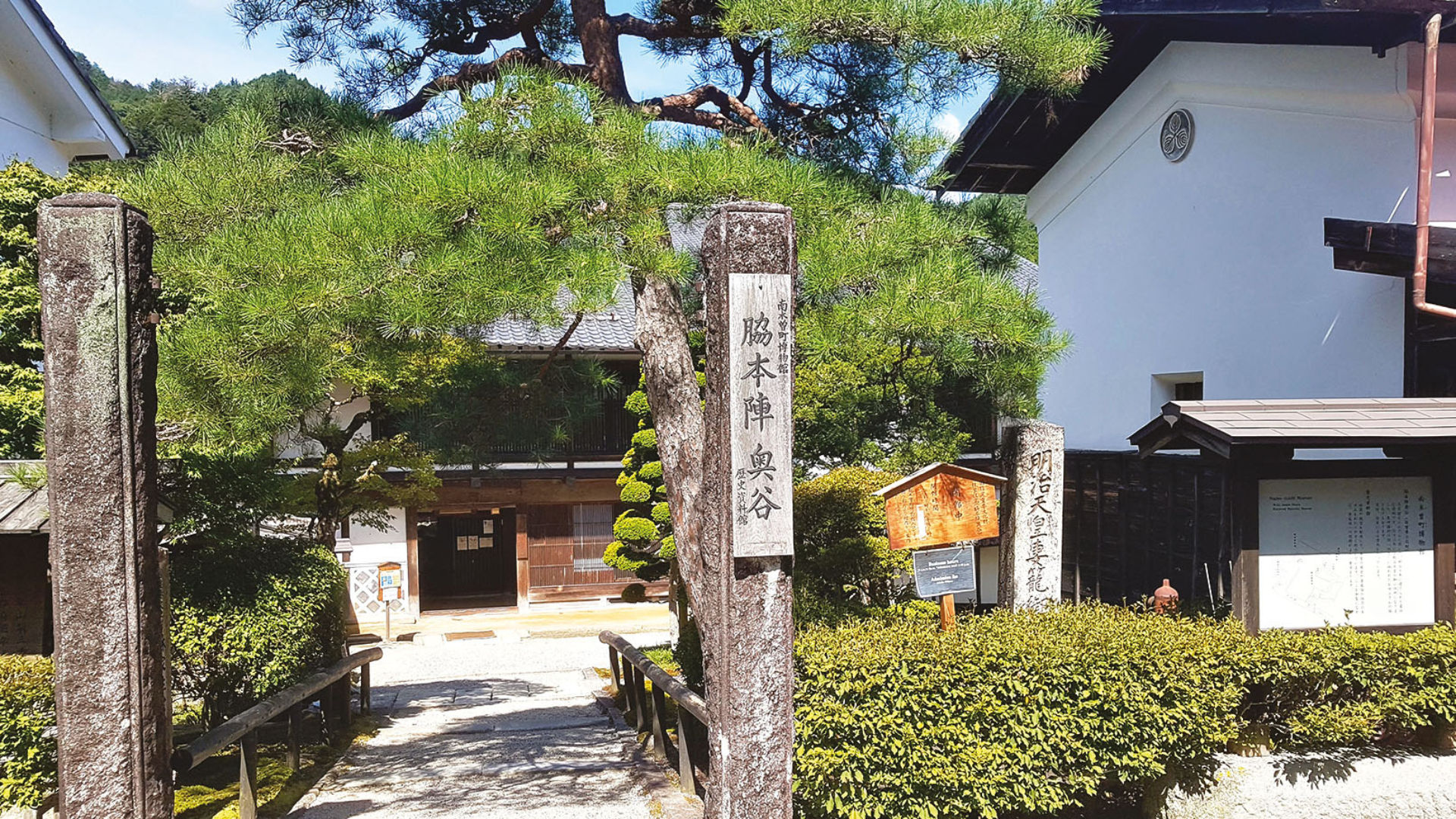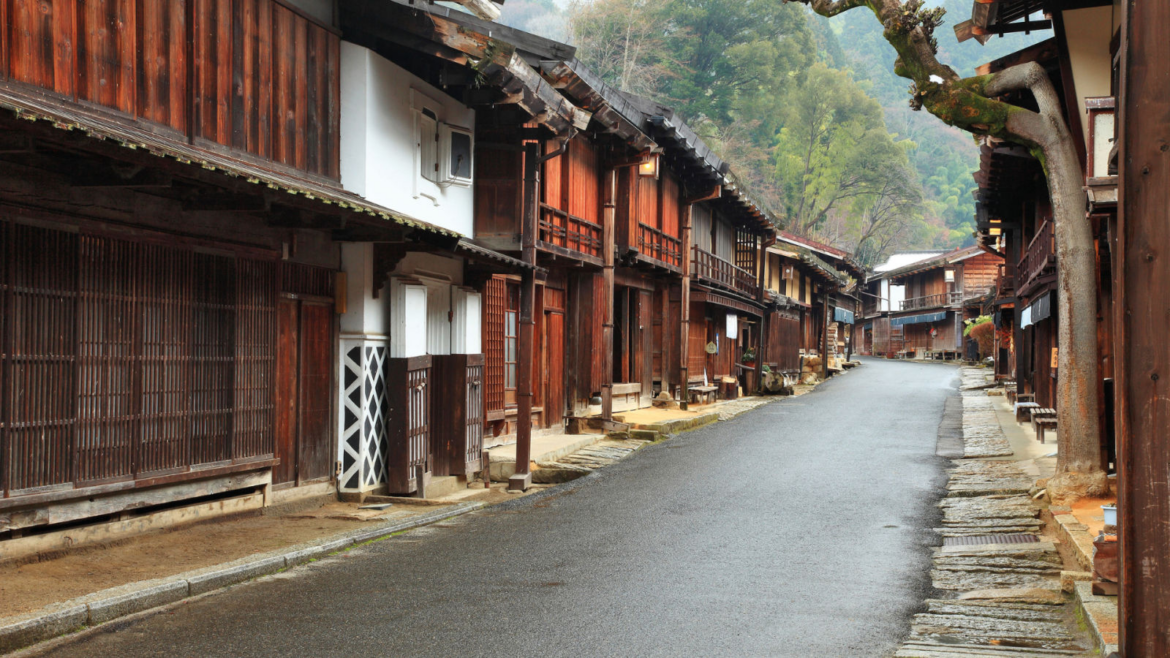
Nagiso is a small town located in the Kiso Valley in the Nagano Prefecture of Japan. (Photo Courtesy: Seigo Yamamura/Aflo/Gettyimages)
I stare at the crisp white piece of paper in front of me before getting down to creating my own multi-coloured print on it. It’s rather simple and involves placing the paper on the table and covering it with a clear cover that has the print of the Kinryiisan Temple in Asakusa. After inking a roller and running it over the paper, voila, my print of the Temple which is the most revered Buddhist Temple in Edo is ready.
 The collection of The Sixty-Nine Stations of the Kisokaidō displays replicas of iconic Japanese prints.
The collection of The Sixty-Nine Stations of the Kisokaidō displays replicas of iconic Japanese prints.
The interactive activity is part of the Nakasendo Hiroshige Museum of Art located in the post town of Ena. The museum is dedicated to Utagawa Hiroshige, a Japanese artist and the last great master of the tradition of ukiyo-e woodblock printing.
Clutching my print rather possessively, I walk around the museum viewing its 1,500 art exhibits. The classic aesthetics—that are synonymous with Japan— are evident in each piece. The spectacular collection of The Sixty-Nine Stations of the Kisokaido is on display. The prints here are replicas—the originals are not displayed at the museum’s permanent exhibition for preservation purposes. However, for a month, in September, the originals are exhibited at the museum.
 The fire at Nagiso-machi Museum symbolises the welcoming tradition of a former inn for nobles.
The fire at Nagiso-machi Museum symbolises the welcoming tradition of a former inn for nobles.
My first initiation into Japanese art is sublime and, eager to experience more, I bid adieu to the post town of Ena to walk to the next location. I am not alone. Our multi-ethnic group, comprising participants from India, Japan, the USA, Australia, and Taiwan, is a lively bunch fuelled by a sense of adventure and curiosity about art. Our tour leader, Abdel Ibrahim, is from the United States and has been living and working in Japan for the last 24 years.
 The Nakasendo Hiroshige Museum celebrates the ukiyo-e tradition, preserving the legacy of Japan’s artistic heritage.
The Nakasendo Hiroshige Museum celebrates the ukiyo-e tradition, preserving the legacy of Japan’s artistic heritage.
As we walk through an old forest, he talks about his love for Japan and the kindness of its people. I mirror his sentiment. Walk Japan, the tour company through which I booked my trip, is a pioneer of off-the-beaten-track walking tours in Japan. Nakasendo Way: The Kiso Road on which I am walking is their signature guided tour. The Kiso Road is part of Nakasendo, an ancient highway route dating back centuries, once used by monks, samurai, and princesses to travel between Kyoto and Edo (now Tokyo).
I feel like a time traveller as we pass through quaint villages, each whispering a cultural legacy that reflects in the generosity of the people. Walk Japan assured me that I would experience the real Japan; and that is exactly what I get on this five-day, small-group, fully guided walking tour. I see Japan’s beauty, breathe her humility, soak in the warmth of her people, and feast on local food that feeds my body, mind, and soul. Walking along a waterfall here, a paddy field there, I don’t realise when we reach Nagiso, a town blessed by Mother Nature and untouched by time. Thick woods greet us as the scenic Kiso River meanders by.
 Nagiso-machi Museum was a former inn for nobles.
Nagiso-machi Museum was a former inn for nobles.
Walking along a waterfall here, a paddy field there, I don’t realise when we reach Nagiso, a town blessed by Mother Nature and untouched by time. Thick woods greet us as the scenic Kiso River meanders by. We walk to the Nagiso-machi Museum, our next cultural venue. The museum, once visited by Emperor Meiji, was a former inn for nobles who were passing through town.
 The wooden writing table, designed for Emperor Meiji, stands as a fine example of Japan’s meticulous craftsmanship.
The wooden writing table, designed for Emperor Meiji, stands as a fine example of Japan’s meticulous craftsmanship.
Our masked-up host invites us to sit around the fire at the entrance. In earlier days, this is where the innkeeper and his family would meet and greet guests. The pot above the burning fire was used to cook food for guests. Our host shows us around, explaining the significance of the in-house shrine and the wooden writing table made for Emperor Meiji.
The next day, we walk past a hydroelectric power station, one of many in Kiso Valley, and continue to explore the forests and mountain paths along the way. Matsumoto, our last destination on the tour, had the honour of hosting the 1998 Winter Olympics. The city brings me back to the reality of civilisation with its hustle and bustle and fast-paced life, a stark contrast to the classic villages that we had left behind.
 Matsumoto Castle stands as a testament to Japan’s medieval warrior heritage.
Matsumoto Castle stands as a testament to Japan’s medieval warrior heritage.
On the last day of the trip, we visit Matsumoto Castle. It takes my breath away. I spend a few minutes admiring it, oblivious to the crowd around me. The imposing multi-storey castle with black wainscoting is what picture-perfect postcards are made of. It is counted among Japan’s premier historic castles and is considered a national treasure. Before entering the main castle, like all visitors, I remove my footwear and carry it with me in the bag provided. The wooden interiors open to a warrior’s running passage that was built to facilitate fully armoured samurai to run in during battle and defend the castle under attack. I climb the steep wooden steps, floor above floor, to relive the splendour of the clans that had occupied the castle.
 A concealed firearm on display at Matsumoto Castle.
A concealed firearm on display at Matsumoto Castle.
On the second floor, in the Matsumoto Castle firearm museum, there is a grand display of weapons. Matchlock gun barrels and muskets fire a grand salute to samurai armour that was made by overlapping metal plates. The showcase displaying concealed firearms is interesting as it shows unusual firearms, including those that could be hidden up a kimono sleeve. In another section, I learn about the ornaments that were placed on the castle rooftop to protect it against fire. I pause to catch my breath after climbing the steps to the fifth floor, as they are the steepest. The sixth floor has a shrine dedicated to Goddess Nijuroku-yashin, who is the guardian deity of the castle. The shrine is situated right below the ceiling.
As I take in the panoramic views of the castle garden from the moon viewing room—only two Japanese castles have these: Matsumoto and Okayama—my favourite location thus far, I realise this trip has been much more than just a tour, it’s been a cultural immersion into the heart of Japan.
Planning a trip to Japan’s Kiso Road
How to Reach
Singapore Airlines via Singapore, Cathay Pacific via Hong Kong, Japan Airlines via Tokyo, and Thai Airways via Bangkok fly to Nagoya. The meeting point and the starting point for Nakasendo Way: The Kiso Road tour is in the JR Nagoya Station in Nagoya. There onwards, the tour leader takes care of everything till the end of the tour finishing in Matsumoto.
When To Visit
Nakasendo Way: The Kiso Road is organised throughout the year with fixed departure dates. The maximum group size per tour is 12 people. Walk Japan organises 35 tours in all seven regions of Japan.
Top Places To Stay
The five-day trip organised by Walk Japan costs INR 1,39,000 per person, twin share . It includes the cost for the tour leader, four nights’ accommodation, all meals, luggage transfers, sightseeing with entrance tickets, and travel from the start till the end of the tour. The included accommodation options range from traditional Japanese inns to a hotel. The traditional Japanese inns include Ena Ichikawa Inn, Maruya Inn and Iwaya Inn that come equipped with onsen thermal hot spring bathing facilities. Matsumoto Hotel Kagetsu is a western-style hotel.
Where To Eat
The tour includes breakfast, lunch and dinner which is eaten either in the traditional inns, hotel or in eateries along the trail. The ingredients are locally sourced and the Japanese kaiseki meal courses mostly range from appetiser, small bowl, sashimi, grilled food, boiled food, fried food, small pot to homemade pickles, miso soup, rice and dessert.
Related: Oh Deer! Everything You Must Do In Nara, Japan’s Beautiful Ancient Capital
Note:
The information in this article is accurate as of the date of publication.
Written By
Khursheed Dinshaw


AloJapan.com